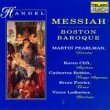[Set 5: Soprano air (B-flat major), Alto recitative (D major - A minor), alto and AIR (SOPRANO)Rejoice greatly, O daughter of Zion, shout, O daughter of Jerusalem: Handel uses a modified A-B-A or da capo form for this air, truly distinguishing between the affects of the two sections. The joyous music of the opening sentiment is almost breathless at first, rising upward as it invokes a rising spirit. Subsequent settings of “rejoice” laugh and dance in longer and longer garlands of sequences. The long high note on “shout” does just that–projects outward to the daughter of Jerusalem. [Excerpt 32] The King comes to Jerusalem through a vigorous descending pattern. The second section is in the relative minor. Its new mode and longer phrases in more regulated note values convey a less giddy mood, a new tone of solemnity worthy of the gravity of righteousness. Separated statements of the word “peace”, on longer notes in the melody and underlaid by a pedal tone in the bass, calm and settle the action in the music as a complete antithesis of the word “rejoice.” [Excerpt 33] The air returns to the first idea, elaborating on it in a written out form rather than simply repeating it. There are longer and more diverse rejoicings and shorter, more highly energized shouts. [Excerpt 34] The instrumental coda provides a further elaboration of the first section’s melody as if clearly delighted with the event. RECITATIVE (ALTO)Then shall the eyes of the blind be open’d, and the ears of the deaf unstopped; Interesting things happen in this brief recitative. The first three text phrases are treated in a rising sequence, as if we are to hear them with growing amazement. In the first two, there is a brief hesitation written in the score (as a rest) before the particular handicap is reversed, but with the third there is no stopping–the lame man rises up unimpeded! The final phrase is cast as an unelaborated fact. Might we assume that the following duet is the song? [Excerpt 35] DUET (ALTO, SOPRANO)He shall feed his flock like a shepherd, and he shall gather the lambs with his arm; The shepherd’s tender care of his flock brings back the pastoral motion of the Pifa, even replicating its compound quadruple meter, form, simple harmonies and long pedal notes of the drone. [Excerpt 36] This is a sequential duet, the alto singing the first “verse” in F major, the soprano the second in B-flat major. The settings are virtually the same in spite of the transposition. [Excerpt 37]
|

